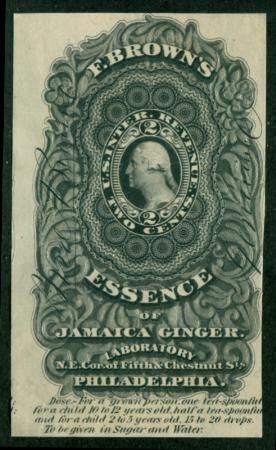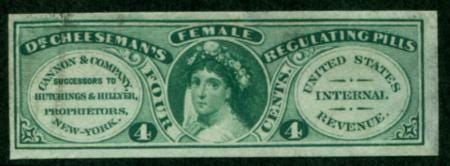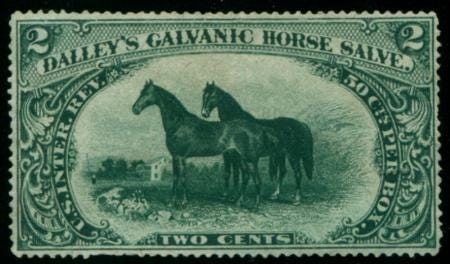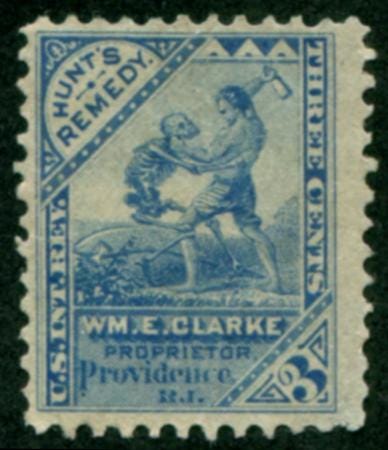Your stamps are on drugs.
Eric Jackson's revenue-stamp auctions are a trove of fascinating medicinal ephemera.
Long, long before anyone thought to issue stamps to show prepayment of postage (for the newbies in the audience, that was in 1840) stamps were being used to collect taxes, mostly on legal documents. That idea actually goes all the way back to 17th-century Holland.
Throughout the 19th century, the use of stamps to collect taxes was gradually applied to more and more things. Stamps were cheap to print and easy to use. Among the most frequently taxed items in Great Britain and the United States were medicines.
Every bottle and packet had to bear a stamp showing the tax on it had been paid, or it could not be legitimately sold. Perhaps perversely, customers began to demand the presence of the tax stamp as a way of making sure they weren’t being sold snake oil. In Britain, stamp designs eventually had to be amended to remind consumers that the mere presence of the stamp did not imply any government guarantee of efficacy.
Medicine stamps in Britain were widely imitated, not to defraud the government of tax revenue, but to lend an air of legitimacy to quack medicines shipped overseas. Yes, the diet-supplement scam has deep roots…
Anyway, today is auction day over at Eric Jackson’s place in Leesport, Pennsylvania. (Eric is probably the best-known revenue stamp dealer in the U.S. His wife, Tami, is on the board of the American Stamp Dealers Association.) I apologize for not including this sale in my Sunday preview, but there’s still plenty of time to head over and browse some of the lots before it closes tonight at 11 pm EDT.
Revenue stamps cover many categories, of course, from playing cards to stock trades to marijuana to duck hunting, but some of the most visually amazing were those issued for medicines. The U.S. enacted a raft of new taxes during the Civil War (it was an expensive conflict) and—following Britain’s earlier example—proprietary drugs were added to the list of taxable items.
One of the options available to manufacturers was to have the government’s own Bureau of Engraving and Printing do just that for them. Not only was the cost nominal, but the government offered drugmakers a rebate on the tax if it could hold onto the stamp die for them, to prevent fraud. Thus was born the category of Private Die Proprietary stamps, listed in the Scott catalog with an “RS” prefix.

The above is a fine example of the genre. As elaborate as a banknote, it is simply a 2¢ U.S. Internal Revenue stamp, custom designed for a Philadelphia firm named F. Brown that was peddling essence of Jamaican ginger. The little effigy of George Washington in the center, modeled on Jean-Antoine Houdon’s famous bust, was the 19th-century equivalent of clip art and gives the whole thing an air of authority. There was enough space at the bottom to include not just the firm’s address—N.E. corner of Fifth & Chestnut Sts.—but also the directions for taking the stuff. This stamp is practically suitable for framing!
They weren’t all so large, but many others were just as beautiful—after all, they were being engraved and printed by some of the greatest talents in the land.

As well as general cures, there were stamps for medicines with specific purposes, such as this 4¢ green for Dr. Cheeseman’s Female Regulating Pills. (Who doesn’t want a well-regulated female? The amount of social as well as medical history encapsulated by this field is extraordinary.)
It’s not clear to me what exactly Hunt’s was offering a remedy for, but it must have been something pretty deadly, because the cartoon of a colonial settler battling an animated skeleton is badass. I wish there were more of these.

It wasn’t all just medicines for people, either. Veterinary remedies were covered, and one of my very favorite revenue stamps is this one for Dalley’s Galvanic Horse Salve. This stamp is naturally very popular with collectors who go after horses as a topic or theme on stamps: the fine engraving on this fairly large issue is something to behold. They certainly put a lot of effort into collecting their 2¢ worth.
I’ve just scratched the surface here. Head on over to the medicine lots at Eric Jackson’s auction to browse more great revenue stamps, and then check out some of the many other categories.
Til tomorrow,





